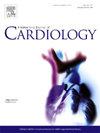The particular anatomy of atrioventricular septal defect with a common valvar orifice in patients with Down syndrome: an echocardiographic study
IF 3.2
2区 医学
Q2 CARDIAC & CARDIOVASCULAR SYSTEMS
引用次数: 0
Abstract
Objectives
Atrioventricular septal defect with a common valvar orifice is associated with Down syndrome in almost half of cases. Clinical studies have shown that associated tetralogy of Fallot is more frequent in Down patients. The aim of this study was to compare the anatomy of the ventricles and of the ventricular component of the atrioventricular septal defect, looking for an outlet septum malalignment like in tetralogy of Fallot, in patients with and without Down syndrome.
Methods
We reviewed retrospectively the echocardiographic examinations of all consecutive patients hospitalized with atrioventricular septal defect with a common orifice between 01/01/2016 and 01/09/2023. Anatomic and functional characteristics were compared between Down and non-Down patients.
Results
A total of 310 patients were included (Down syndrome 210, 67.7 %). Outlet extension of the ventricular component of the defect with outlet septum anterior malalignment was found in 90.6 % of Down vs 12.8 % of non-Down patients (p < 0.001). Hypoplasia and apical filling of the right ventricle were more frequent in Down patients (p < 0.001). Associated tetralogy of Fallot was found in 16 Down vs 1 non-Down patients (p = 0.04). Atrioventricular septal malalignment was observed only in Down patients.
Conclusion
Outlet extension of the ventricular component of the defect is the rule in atrioventricular septal defect with a common orifice in Down patients, which could influence surgical repair. Hypoplastic right ventricle occurs only in Down patients. The presence of these characteristics in a fetus with atrioventricular septal defect with a common orifice should raise awareness of the high risk of associated Down syndrome.

求助全文
约1分钟内获得全文
求助全文
来源期刊

International journal of cardiology
医学-心血管系统
CiteScore
6.80
自引率
5.70%
发文量
758
审稿时长
44 days
期刊介绍:
The International Journal of Cardiology is devoted to cardiology in the broadest sense. Both basic research and clinical papers can be submitted. The journal serves the interest of both practicing clinicians and researchers.
In addition to original papers, we are launching a range of new manuscript types, including Consensus and Position Papers, Systematic Reviews, Meta-analyses, and Short communications. Case reports are no longer acceptable. Controversial techniques, issues on health policy and social medicine are discussed and serve as useful tools for encouraging debate.
 求助内容:
求助内容: 应助结果提醒方式:
应助结果提醒方式:


